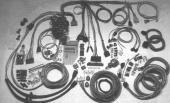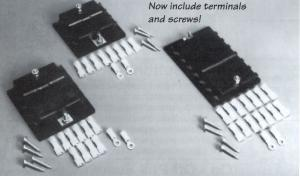Wiring Panels 2
Here’s the PDF Download of this article.
Wiring Panels & Kits
by Steve Watson
Watson’s StreetWorks Rod & Custom
Getting what you want and what you need –
You took one look under the dash of your ’34 and knew that new wiring was a must. The mess
looks something like a raw Klingon breakfast delicacy. Or maybe your old VW isn’t up for the
extras that you have in mind to add – especially with only a few ceramic fuses! Take Heart!
This booklet on Wiring Panels & Kits was written to give you the best information so that you
can get the right parts for your wiring job… the first time!
Questions You Need to Ask
To start – How many electrical do-dads do you plan on having? Will they be battery or ignition
controlled circuits? What amperage does each require? Need room for future expansion? How
much do I want to spend? How knowledgeable am I with wiring? Do I need the “extras” that are
in the kits?
The answers to these questions will lead you to make selections in the following areas: (1)
Panel or full wiring kit? (2) Basic or “Top End” complete kit? (3) How many circuits (fuses) and
connections for both battery and ignition circuits? (4) Integral Fuse Panel or Modular Panel
System? Let’s take a look at each of these questions so that we can make the right choices.
Who’s doing this job…anyway?
O.K., we know that we’re all do-it-yourself kind of people. And I¹m here to tell you that wiring a
car isn’t all that big of a job. But it rates right up there in the top three things that we will “farmout”
to have someone else do – those are paint, upholstery and electrical. Why? Because the
difference between an amateur and a professional job can be significant! We know their
importance. Safe and good looking electrical power to our project is a must.
People who don’t know electricity can often be afraid of it. Worse yet, there are companies out
there who push the “fear thing” in order to sell you product – the ‘buy our stuff and you won’t fry’
advertising. But it’s not that way if you follow very basic rules. For example, fuse each circuit
properly, including fusible links with the right size fuse. Protect wires that might get rubbed.
Secure wires to prevent excess movement. Don’t do a “cheap” job, read instructions and follow
them. Oh, and get our Basic Auto Electricity Book! It’s a steal at just $7.95 + S/H.
So, are you going to do the job or are you going to farm it all out? The answer to that question
will tell a lot about how complicated you want to get. Complicated? By that we mean how much
work is required. And how much you want to spend. Doing a big job or a little job requires the
same amount of knowledge but a different amount of time and effort. Doing it yourself saves
expense, but at the possible sake of quality (although we hear horror stories every day about
“experts”). Buyer beware!!!
Panel or Full Wiring Kit?
What does your ride need? A full rewiring or just a new fuse
panel? Most vehicles that need rewiring need the whole ball-of-wax
– if that’s the case, tear it all out and start over again, NEW. This is a
hard decision to make but if you are going to go through the
expense and effort to begin with, then it is best to go all the way and
do it right.
In a few cases, the choice of a new fuse panel is appropriate. If the existing wiring is in good
condition and there is no need to add additional circuits, AND if the old fuse panel is easily
replaced, then the addition of a new panel can be a good choice. However, replacing just an
existing fuse panel is seldom an easy job.
Most original and after-market fuse panels are of the “Integral Fuse Panel” type. This means
that the wiring is preterminated to the fuse panel. Replacement of just the panel would require
clipping all of the wires and reconnecting to the new panel. If there is an excess of “old” wire
length and if the new panel is a Modular Unit (we will discuss these soon), then this can be O.K.
Otherwise, it will be a major pain in the butt connector.
In very few rewire cases will a new fuse panel ONLY be the best decision. In most cases where
the entire vehicle needs to be rewired, you should go with a full vehicle wiring kit – fuse panel,
wiring, and whatever else it needs.
Brand new, first time wiring jobs done by knowledgeable people can frequently use “panel
only” kits and do the rest of the wiring on their own. After all, a wide variety of wire sizes and
colors are available at any good parts store. But seldom will this approach end up costing less
or producing a better job. It just drags out the expense and adds numerous trips to the parts
store. Basic pick-ups, dune buggies and kit cars are examples where panel-only wiring jobs are
more common. The key to success is having a knowledgeable person doing the work. A good,
complete wiring kit with quality instructions helps to bridge the knowledge gaps for the first time
automotive electrician.
Basic or “Top End” Kit?
Top end kits are more complete with all of the stuff you will need. Basic kits give you…well, the
basics. Either way, go for a quality kit.
A quality kit Will have –
- the manufacturers name right up front (reputation does count!)
- color coded wiring (preferably GM standards)
- line marked applications on every wire
- quality instructions – computer generated with a phone number to call in
case of problems or questions
A quality kit WILL NOT –
- tell you that you can use ONLY their parts with their kits (electricity
doesn’t know manufacturers) - tell you that using anyone else’s parts will void their warrantee (cop an
attitude).
Top end or basic, look for a quality kit from a quality source.
How many circuits?
You will need to know what electrical items you are going to have. The number of circuits
depends upon the number of different items and whether they need to be fused independently
(by themselves) or whether two or three items can be run through one fuse.
The Basic 8
For any vehicle being used on the street, there are 8 basic circuits. Four are battery fed
(powered all of the time) and four are ignition fed (powered only when the ignition or accessory
systems are on).
The battery fed circuits are:
- Horn
- Headlights/Running Lights
- Brake Lights
- Hazards (if equipped).
The ignition fed circuits are:
- Gauges
- Heat/Defrost Fan
- Wipers
- Turn Signals (if equipped)
You can see why they’re called the basic 8…no frills here.
Additional circuits include:
- Radio/Auxiliary Radio
- Separate Tail Light Fuse
- Separate Park Light Fuse
- Entry Latch Release
- Radiator Fan
- Fuel Pump
- Power Windows/Seats
- Power Door Locks
- etc., etc., etc.
A rule of thumb – 12 is good unless you want “power” (windows, seats, etc.). With power, go to
18 circuits minimum.
Integral Fuse Box or Modular Panel?
Integral Fuse Box wiring kits are the most common kits available.
They are often called “OEM” kits because they look like what you
would find under the dash of any Detroit vehicle and, in fact, use
those same components. Distinguishing features are the OEM
looking fuse box with preterminated wires leading into a large “pig
tail” with connectors attached. These kits give a “factory look” by
using factory parts, which make them less expensive and a lot of the
work is already done. One drawback is that big pig tail – wrestling with it, mounting and hiding it
neatly.
The other approach is a Modular Fuse Panel kit where the fuse box is literally a separate
“module” preterminated to a connection block. No pig tail here.
The modular panel packs more circuits into a smaller, neater package making fuse box
mounting an easier job. Wiring is done one circuit at a time and can be made “show car” neat
even by a first-timer. The one drawback here is that the parts are less common making the kits
a little more expensive.
Review Time…
O.K. We’ve covered a lot of items. Let’s review –
(1) we’ve decided on whether to do the job ourselves or find a professional.
(2) We’ve chosen between putting in a fuse panel only or a complete wiring kit.
(3) We’ve selected between a quality top-end kit with more features and components or a
quality basic kit (remember that either way you want a quality kit from a quality source).
(4) We know what features we want in our vehicle and therefore how many circuits the fuse
panel needs to have. And
(5), we’ve considered the difference between an OEM style Integral Fuse Box and a Modular
Fuse Panel and decided which will give us the finished job that we want.
Price…Ya, price.
None of us has bottomless pockets, so what we are willing to spend for a wiring kit always
becomes an issue. But like anything, we can get burnt by spending too much or too little.
Here’s some numbers for guide lines –
For fuse panels only, expect to spend about $50 +/- for a basic panel without flashers, relays,
etc., price varying with the number of fuses.
For top end fuse panels expect to pay a minimum of about $100 for an 8
to 12 fuse panel with the price going up from there very quickly to over
$200. If you are looking at a higher priced panel, we suggest you consider
a complete wiring kit because you’re not going to save much money
buying a panel only.
Prices for complete wiring kits with fuse panels should run in the $325 – $375 range for Integral
Fuse Box kits and up to about $425 for Modular Fuse Panel kits and near $500 for “deluxe”
Modular Panel kits. What makes them deluxe except the price? More circuits, more connections
and maybe more included switches, etc. (These price guides were set in mid 2013, Wire kit
prices are strongly affected by the price of copper.)
How about price guides for professional installation? We’re not going to touch that one. Prices
will vary a lot due to location, experience and demand. BUT – we strongly suggest that you get a
price for the whole job, not work done by the hour. A reasonable sounding hourly rate may end
up costing you big time. Also get a PRICE for specific itemized work, not an estimate. A pro will
know what it takes to do your job and will stand behind their work.
Add-on Panels
One last subject to mention is Add-on Fuse Panels. With add-on’s you’re not rewiring your
whole car, you’re just adding fused circuits to cover new accessories like power windows or
auxiliary lighting, etc. Keep in mind that these are not band-aides for an ailing electrical system.
They are additions for when you need more circuits (fuses) than your present system has.
It’s also comforting to know that you can rewire your whole car and, if
you picked too small a fuse panel to begin with, have a safe, neat way
to fuse extra circuits. Add-on panels can come with a variety of inputs
depending upon what you need and what’s easiest for you. For example, the Power Tap shown has a single input for all 6 fused circuits so they will all be battery or ignition fed
but not both. The PanelTech fuse panels shown
have separate inputs for battery and ignition
circuits (the 14 circuit panel is split 8/6). Or you
can get add-on’s like the ones shown on this page that have individual inputs for each fuse so
that you can choose or change the input source as needed. With any of these panels, you get
extra circuits with a minimum of hassle.
A word about American AutoWire
Here at Watson’s StreetWorks we carry American AutoWire wiring kits. Why? Because we think
they are the best wiring kits available at any price. They are backed by decades of experience
making their “Factory Fit” products for OEM replacement harnesses. They are engineered
products, planned and designed to work right for you. And they back their products after-thesale.
In the rare occasion that you have a question or a problem, they are there for you. And so
are we. When you buy a quality product from a quality manufacturer and supplier you’re getting
the best you can get.
Here’s the PDF Download of this article.







2 Comments
Trackbacks and Pingbacks
[…] […]
[…] […]